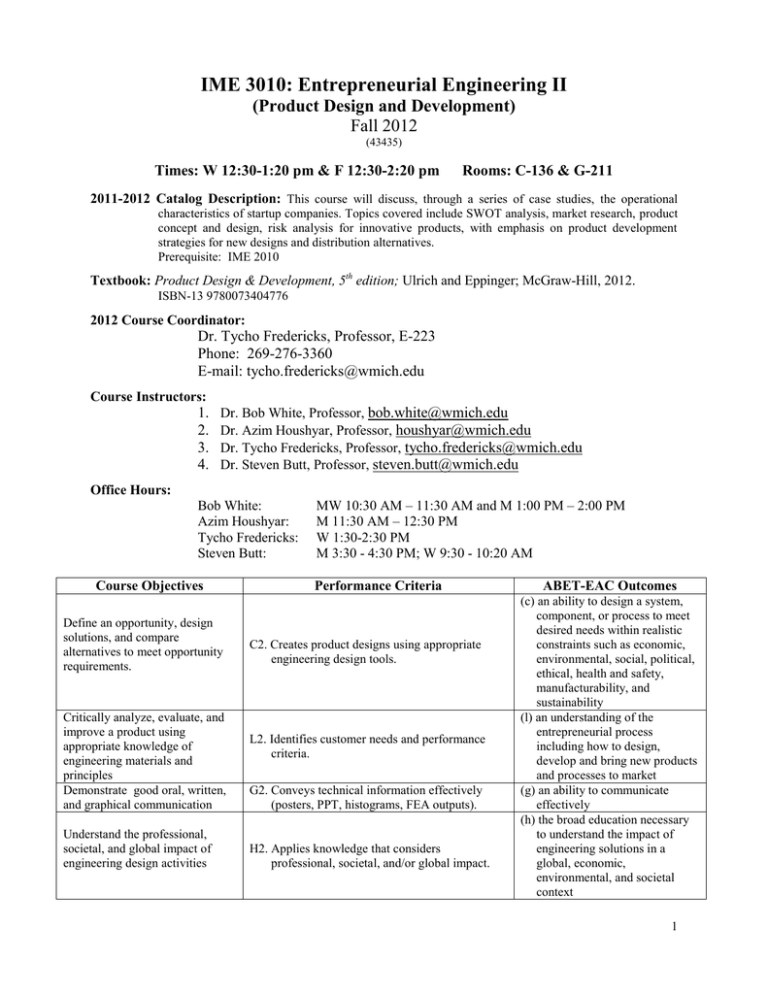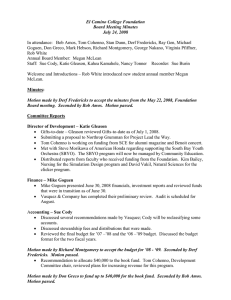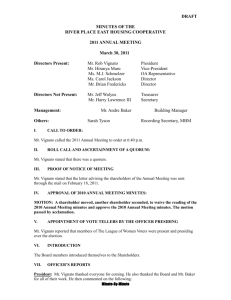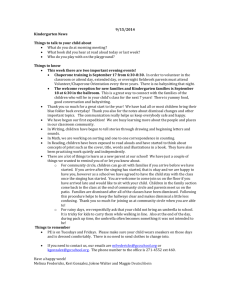IME 3010: Entrepreneurial Engineering II (Product Design and Development) Fall 2012
advertisement

IME 3010: Entrepreneurial Engineering II (Product Design and Development) Fall 2012 (43435) Times: W 12:30-1:20 pm & F 12:30-2:20 pm Rooms: C-136 & G-211 2011-2012 Catalog Description: This course will discuss, through a series of case studies, the operational characteristics of startup companies. Topics covered include SWOT analysis, market research, product concept and design, risk analysis for innovative products, with emphasis on product development strategies for new designs and distribution alternatives. Prerequisite: IME 2010 Textbook: Product Design & Development, 5th edition; Ulrich and Eppinger; McGraw-Hill, 2012. ISBN-13 9780073404776 2012 Course Coordinator: Dr. Tycho Fredericks, Professor, E-223 Phone: 269-276-3360 E-mail: tycho.fredericks@wmich.edu Course Instructors: 1. 2. 3. 4. Dr. Bob White, Professor, bob.white@wmich.edu Dr. Azim Houshyar, Professor, houshyar@wmich.edu Dr. Tycho Fredericks, Professor, tycho.fredericks@wmich.edu Dr. Steven Butt, Professor, steven.butt@wmich.edu Office Hours: Bob White: Azim Houshyar: Tycho Fredericks: Steven Butt: Course Objectives Define an opportunity, design solutions, and compare alternatives to meet opportunity requirements. Critically analyze, evaluate, and improve a product using appropriate knowledge of engineering materials and principles Demonstrate good oral, written, and graphical communication Understand the professional, societal, and global impact of engineering design activities MW 10:30 AM – 11:30 AM and M 1:00 PM – 2:00 PM M 11:30 AM – 12:30 PM W 1:30-2:30 PM M 3:30 - 4:30 PM; W 9:30 - 10:20 AM Performance Criteria C2. Creates product designs using appropriate engineering design tools. L2. Identifies customer needs and performance criteria. G2. Conveys technical information effectively (posters, PPT, histograms, FEA outputs). H2. Applies knowledge that considers professional, societal, and/or global impact. ABET-EAC Outcomes (c) an ability to design a system, component, or process to meet desired needs within realistic constraints such as economic, environmental, social, political, ethical, health and safety, manufacturability, and sustainability (l) an understanding of the entrepreneurial process including how to design, develop and bring new products and processes to market (g) an ability to communicate effectively (h) the broad education necessary to understand the impact of engineering solutions in a global, economic, environmental, and societal context 1 Evaluation: Your grade in this class will be based primarily on your demonstrated grasp of the material and ability to think entrepreneurially. If you ever have any question as to what this means in your assignments – ask the instructor immediately. The instructors also expect you to challenge them throughout this class in deepening your understanding of the entrepreneurial process. There is almost nothing you cannot ask the instructors. Your final grade will be based on the following: 1) Assignments/Quiz/Case Studies 2) 3) 4) 5) Fredericks/Butt (6.67%); White (6.67%); Houshyar (6.67%) Midterm Assessment (Initial Models, Presentation) 10% Public Presentation (Video, Poster, Public Judging) 15% Final Assessment (Presentation) 15% Term Project (Working Model, Final Report) 40% Grading Scale: 93 - 100 83 - 87 73 - 77 60 - 67 A B C D 88 - 92 78 - 82 68 - 72 Below 60 20% BA CB DC E Attendance Policy: Attendance is mandatory. The student will receive a score of zero for any assessment item not submitted because of absence (This includes the assignments, case studies, projects, reports, and quizzes.) Extreme circumstances will be considered on an individual basis, however, when possible arrangements must be made prior to the due date, and supporting documentation is necessary. Academic Honesty Policy: Same as the university's policy You are responsible for making yourself aware of and understanding the policies and procedures in the Undergraduate Catalog that pertain to Academic Honesty. These policies include cheating, fabrication, falsification and forgery, multiple submission, plagiarism, complicity and computer misuse. [The policies can be found at http://catalog.wmich.edu under Academic Policies, Student Rights and Responsibilities.] If there is reason to believe you have been involved in academic dishonesty, you will be referred to the Office of Student Conduct. You will be given the opportunity to review the charge(s). If you believe you are not responsible, you will have the opportunity for a hearing. You should consult with your instructor if you are uncertain about an issue of academic honesty prior to the submission of an assignment or test. Homework/Case studies: Homework assignments and case studies are to be turned in at the beginning of lecture on the day they are due. Assignments will be announced in the class. Late submissions will not be accepted! You will receive a score of zero for each assignment that you fail to turn in at the specified time. (Note: Only one copy of a written report is necessary for each team assessment item). Assessments: The assessments will be administered during the lecture period on the days indicated in the schedule. You are responsible for the material up to the day of the assessment. Each assessment could consist of an interim report on your project as well as questions and problem sets. 2 Semester-Project: Product Design and Development Project You are expected to divide into teams and use the knowledge gained in this course and others to design and develop a working model of a physical product. Each team is asked to begin this process by identifying 10 opportunities by the end of the second week. The project product options to select from are noted below: Develop a product useful to people living in an emerging/developing economy Develop a toy which has a very clear educational component Develop a product which can help save lives in turbulent weather, natural or man-induced disasters Develop a product which campers, trekkers, or outdoors people would find useful Develop a product which is useful to police, fire departments, or emergency service organizations Develop a product which has significant health benefits Develop a product which is fully aligned with the objectives of this class but is different from the options noted above. We would encourage you to think about products that would have a social, environmental, or humanitarian impact. The IEE faculty will review these proposals and will accept one or more of these products for further design and development, or will ask the team to develop a new proposal. General Guidelines to Consider and Keep in Mind We want you to produce a physical working model of your product by the end of the course. As a result, we insist that your product be simple. Following are the guidelines we are asking you to following as you consider possible projects: There should be a demonstrable market for the product. One good way to verify a market need is to identify existing products that meet the need. Your product need not be a variant of an existing product, but the market need addressed by your product should be clearly evident. The product does not have to have a tremendous economic potential, but should at least be an attractive opportunity for a small firm. The product should be a material good and not a service. Although many of the ideas in the course apply to services (e.g., customer needs and product architecture), many do not (e.g., design for assembly). The product should have a high likelihood of containing fewer than 10 parts. Although you cannot anticipate the design details, it is easy to anticipate that an electric drill will have more than 10 parts and that a garlic press will probably have fewer than 10. You should be confident of being able to model the product for less than $100 - $200. For example, a new Gillette razor may have about 10 parts, but would require tens of thousands of dollars to prepare a geometrically accurate prototype. The product should require no basic technological breakthroughs. (Yes, a more compact airbag would be a nice, but can you do it without inventing a new chemical?) We do not have time to deal with large technological uncertainties. You should have access to more than 5 potential lead users of the product (more than 20 would be nice). Save any highly proprietary ideas for another context; we will be quite open in discussing the projects in class and do not wish to be constrained with sensitive information. The most successful projects tend to have at least one team member with strong personal interest in the target market. It is really nice to have a connection to a commercial enterprise that may be interested in the product. A good source of project ideas is to ask business people you know what products they would really like to have. Most products are really not very well designed. We are continually amazed at the seemingly poor quality of common products (utility knives, garlic presses, and ice cream scoops, for example). Our experience is that if you pick almost any product satisfying our project guidelines, you will be able to develop a product that is superior to everything currently on the market. 3 SCHEDULE Week Date September 5 1 September 7 Topic Introduction (Chapter 1), Previous Projects, Requirements for IME 4010 Development Processes and Organizations (Chapter 2), Opportunity Identification (Chapter 3), Product Planning (Chapter 4) Items Due Instructor(s) All Team Formation Fredericks September 12 Identifying Customer Needs (Chapter 5) September 14 One-Minute Team Pitches September 19 Work Day: Identifying Customer Needs September 21 Team Presentations September 26 Industrial Design /Design Thinking (Chapter 11) Fredericks September 28 Prototyping (Chapter 14) Fredericks October 3 Product Specifications (Chapter 6) Finalized Opportunity with Updates (I2) White October 5 Concept Generation (Chapter 7) Product Specifications White October 10 Concept Selection (Chapter 8) White October 12 Work Day: Concept Generation / Prototyping All October 17 Concept Testing (Chapter 9) White October 19 Work Day: Concept Generation / Selection / Testing All October 24 Project Work Day Fredericks 2 Ten Opportunities All Fredericks 3 Three Opportunities w/ Customer Needs All 4 5 6 7 8 White October 26 First Team Project Assessment Presentation, Initial Models (H2) & Drawings October 31 Project Work Day First Team Peer Assessment November 2 Project Work Day All November 7 Project Work Day All November 9 Project Work Day All November 14 Product Architecture (Chapter 10) / Design for Manufacturing (Chapter 13) Houshyar November 16 Project Work Day All November 21 Thanksgiving Break - Project Work November 23 Thanksgiving Break - Project Work November 28 Project Work Day All All 9 10 11 12 13 November 30 December 5 14 December 7 15 December 12 (Finals Week) Presentation of Final Prototype to the Public – External Judges Robust Design (Chapter 15), Transitioning Prototype to IME 4010 Patents & Intellectual Property (Chapter 14) – Guest Speaker Thursday 2:45-4:45 PM Final Team Project Assessment All Working Model, Poster Presentation, Video Pitch (G2) All Houshyar Final Documentation (Report) (C2), Final Peer Assessment Houshyar Presentation, Final Working Model All 4


